SELEN_LAYOUT_Layout 11/25/14 2:06 PM Page 42
5G WIRELESS ACCESS:
REQUIREMENTS AND REALIZATION
We are just at the beginning of a transition into a fully connected Networked Society that will
provide access to information and sharing of data anywhere and anytime for anyone and
anything. Thus, in the future wireless access will not only be about connectivity for people
but for anything that benefits from being connected.
Erik Dahlman, Gunnar Mildh, Stefan Parkvall, Janne Peisa, Joachim Sachs,
Yngve Selén, and Johan Sköld
P
METIS
Exploratory
research
Propag
testb
2
2013
2014
2
‘12
WR
VISION recommendation
CHNOLOGY TRENDS
port
IMT>6GHz
report
The authors are with
Ericsson Research.
ABSTRACT
5G, the mobile communication technology
for beyond 2020, will provide access to informa-
tion and the sharing of data anywhere and any-
time for anyone and anything. This paper
describes the current status of the processes
moving toward 5G, or “IMT for 2020 and
beyond,” in ITU-R. We also provide a view of
5G opportunities, challenges, requirements and
technical solutions.
INTRODUCTION ANDCHALLENGES
Mobile communication systems have evolved
from supporting analog voice only to powerful
systems providing hundreds of thousands of dif-
ferent applications to billions of users. We are
just at the beginning of a transition into a fully
connected Networked Society
that will provide access to infor-
mation and sharing of data any-
where and anytime for anyone and
anything. Thus, in the future
wireless access will not only be about connectivi-
ty for people but for anything that benefits from
being connected. This includes such diverse
things as household appliances, traffic control
and safety functions, infrastructure monitoring
systems, medical equipment, and much more. As
a consequence, compared to the wireless net-
works of today, next-generation wireless access
will support a much wider range of use case
characteristics and corresponding access require-
ments.
Next-generation mobile communication will
not be available until after 2020. The global
research efforts already underway are exempli-
fied by [1], as well as by projects such as the
METIS project in Europe [2]. Research is likely
to continue for a few more years from now before
the standardization and eventual commercializa-
tion of the system begin. However, we already
have a relatively clear view of the main chal-
lenges and opportunities, as well as the key tech-
nology components of the future 5G systems [3].
Conventional mobile-broadband (MBB)
applications will continue to drive demand for
higher traffic capacity and higher end-user data
rates within the wireless-access network. In
terms of traffic demand, predictions range from
hundreds of times to more than a thousand
times higher traffic in the next 10 years [3, 4].
Most of this traffic, primarily video, will come
from “conventional” mobile broadband access.
But compared to the networks of today future
wireless networks must offer radically lower cost
and energy consumption per delivered bit to
carry the massive traffic affordably and sustain-
ably.
The provisioning of higher end-user data
rates, allowing for faster access to information,
has been the key driving force for the develop-
ment and evolution of 3G and 4G wireless-
access technologies. This quest will continue in
the future. For next-generation wireless-access
networks we envision data rates on the order of
10 Gb/s for specific scenarios, such as indoor
offices and university campuses. More impor-
tantly, data rates of more than 100 Mb/s should
be generally available in urban and suburban
environments. And finally, to provide a truly
ubiquitous connectivity, rates of at least a few
Mb/s should be available essentially everywhere,
including far-off rural and deep indoor environ-
ments.
However, enhanced mobile broadband with
its corresponding demand for higher traffic
capacity and data rates will be only one of the
drivers for the development of next-generation
wireless access. In addition, new machine-type-
communication (MTC) use cases will impose
other sets of requirements, as shown in Fig. 1
and described in the following.
Although the access latency offered by LTE
is sufficient for most mobile-broadband applica-
tions, it may not be sufficient for latency-critical
applications, such as traffic safety, infrastructure
protection, or emerging industrial Internet appli-
cations. To ensure support for
such mission-critical MTC appli-
cations, next-generation wireless
access should allow for latencies
on the order of 1 ms or less.
Even more important, full support for mis-
sion-critical MTC applications will require ultra-
reliable connectivity with essentially guaranteed
availability. Also, reliability-of-service will have
to be orders of magnitude higher than current,
already highly reliable, networks.
On the other side of the scale is a vision of
massive MTC connectivity, with tens of billions
of low-cost connected devices and sensors. To
realize this vision, 5G must enable the availabili-
ty of truly low-cost devices. Furthermore, if they
are to operate over several years without
recharging, future wireless devices, including all
sorts of sensors, should operate with extremely
low energy consumption.
Thus, as outlined in Fig. 2, next-generation
wireless access should extend the performance
and capability of wireless access networks in
many dimensions. As indicated in the figure,
some of these extensions and enhancements —
for example, in terms of traffic capacity and
high data rates — are primarily driven by the
conventional MBB use case. Others, requiring
extreme reliability and support for truly massive
numbers of devices, are driven more by new use
cases, for example, mission-critical and massive
MTC.
COMMUNICATIONS
S
S
T A N D A R D
42
0163-6804/14/$25.00 © 2014 IEEE
IEEE Communications Magazine — Communications Standards Supplement December 2014
�
SELEN_LAYOUT_Layout 11/25/14 2:06 PM Page 43
Massive MTC
Low cost
Low energy
Small data volumes
Massive numbers of devices
Ultra reliable
Very low latency
Very high availability
25389
25389
25389
Sensors, actuators
Low protocol overhead
Scalable access
Capillary networks,
short-range radio
...
$
ms-level latency
Robust transmission
Fast channel assignment
Multi-level diversity
...
Critical MTC
Industrial
applications
Capillary networks
Traffic safety/control
Smart grid
Figure 1. Novel machine-centric use cases for 5G and corresponding requirements.
THEITU-R PROCESS FORDEFINING5G
ITU-R Working Party (WP) 5D is responsible
for the overall radio system aspects of Interna-
tional Mobile Telecommunications (IMT) sys-
tems. These consists at present of IMT-2000
(3G) and IMT-Advanced (4G). WP5D has the
prime responsibility within ITU-R for issues
related to the terrestrial component of IMT,
including technical, operational and spectrum-
related issues. For this purpose, the group devel-
ops and maintains recommendations, including
the radio interface specifications for IMT-2000
systems in ITU-R Recommendation M.1457 [5]
and for IMT-Advanced in ITU-R Recommenda-
tion M.2012 [6].
WP5D is now working on three deliverables
for “IMT for 2020 and beyond,” which corre-
sponds to 5G, for the next World Radio
Congress WRC-15. The main deliverable is a
recommendation referred to as the IMT Vision
[7]. It will define the:
Roles of IMT in future society.
Framework and overall objectives of the
future development of IMT for 2020 and
beyond.
Key capabilities and technical enablers.
This recommendation will be complemented
by two technical reports. One report on technol-
ogy trends [8] will describe the technical aspects
of terrestrial IMT systems during 2015-2020 and
beyond, including the evolution of IMT. A sec-
ond report will describe the technical feasibility
of IMT in the bands above 6 GHz [9].
As shown in Fig. 3, the recommendation for
the IMT Vision will be completed in advance of
WRC-15; the above mentioned two reports will
then serve as input for completing the recom-
mendation. This initial work within ITU-R ties
in well with the ongoing global exploratory
research activities on 5G in METIS and other
projects. The next steps after WRC-15 are for
WP5D to set technical performance require-
ments and to develop an evaluation process for
5G. Following the evaluation, a consensus-build-
ing process will result in radio interface specifi-
cations for 5G, similar to the ones for IMT-2000
and IMT-Advanced [5, 6]. Note that so far no
official name has been chosen for 5G in ITU-R.
An essential part of the IMT Vision is to
User
data rate
data rate
Peak
S
e
f
p
f
e
i
c
c
i
t
e
r
n
u
c
m
y
N
e
t
w
User asp
e
cts
M
o
b
ilit
y
y
c
n
e
t
a
L
o
rk aspects
Energy
efficiency
n
c ti o
sit y
o
C
e
n
n
e
n
d
Figure 2. 5G use-case categories and the corresponding key areas for enhance-
ments.
define new key capabilities for 5G, and to relate
these to the key use cases and scenarios for 5G.
Many key capabilities are enhancements of exist-
ing 3G and 4G capabilities, while others are new
capabilities not originally envisioned for 3G and
4G. Figure 2, currently under discussion in
WP5D, shows one way of illustrating capabilities
deemed essential for 5G. It further connects
these key capabilities to the main use cases driv-
ing them.
SPECTRUM FOR5G
To enable the expected massive traffic increase,
additional spectrum will have to be assigned to
mobile wireless communications. For the 2015
World Radio Conference (WRC-15), the focus
IEEE Communications Magazine — Communications Standards Supplement December 2014
43
�
SELEN_LAYOUT_Layout 11/25/14 2:06 PM Page 44
To fulfill long-term traf-
fic demands and, per-
haps even more
important, to enable
the very wide trans-
mission bandwidths
needed for multi-Gb/s
data rates efficiently,
next-generation wire-
less access will extend
the range of operation
to frequencies
above 10 GHz.
METIS
Exploratory
research
Pre-standardization
activities
and technology
development
Standardization
activities
Commercialization
Propagation measurements,
testbeds, prototyping
Trials
Live 5G systems
2012
2013
2014
2015
2016
2017
2018
2019
2020
WRC ‘12
WRC ‘15
WRC ‘18/’19
ITU-R
WP5D
activities
VISION recommendation
TECHNOLOGY TRENDS
report
Next
steps
IMT>6GHz
report
Technical performance requirements,
evaluation criteria, proposals, evaluation
process, consensus building, etc.
→ Resulting in “IMT-2020” specifications
Figure 3. ITU-R Time plan for the work on IMT for 2020 and beyond.
will be on ensuring additional spectrum below
6.5 GHz. However, to fulfill long-term traffic
demands and, perhaps even more important, to
efficiently enable the very wide transmission
bandwidths needed for multi-Gb/s data rates,
next-generation wireless access will extend the
range of operation to frequencies above 10 GHz.
Identifying and allocating new spectrum
beyond 10 GHz for mobile wireless communica-
tions is expected to be on the agenda at WRC-
18/19. At this stage the entire range of spectrum
from 10 GHz up to 70 GHz or even higher (well
into what is commonly referred to as the mil-
limeter-wave [mmW] range) is being considered.
Research and concept development of future
wireless access must cover the entire spectrum,
from currently used spectrum at 1 GHz and even
lower all the way up to and including mmW fre-
quency bands.
We do not believe that addressing this very
wide range of frequencies with a single radio-
interface structure is the best approach. Issues
such as propagation characteristics, implementa-
tion aspects, and, for certain frequency bands,
compatibility with legacy technologies impose
different constraints that affect the basic radio-
interface design (see Fig. 4).
Up to a certain frequency range, radio inter-
face design can be based on the same principles
as current wireless technologies. One would then
assume relatively wide-area coverage, high-per-
formance radio-frequency (RF) design, and so
on. An OFDM-based transmission technology
will most likely remain a good baseline, although
the detailed numerology would probably need to
be adjusted to match frequencies above 10 GHz.
However, for even higher frequency bands,
propagation characteristics and implementation
aspects speak in favor of a more simplified radio-
interface structure targeting shorter range com-
munications (so called ultra-dense deployments),
allowing for more relaxed requirements on, for
instance, RF parts.
Furthermore, one needs to take into account
that around 2020, when next-generation wireless
access is expected to reach the market, LTE will
be heavily deployed in licensed spectrum below
6.5 GHz. It is highly desirable if next-generation
wireless access can be introduced without
impacting existing deployments and that service
can be provided to existing user devices. Thus, in
such frequency bands, it should be possible to
introduce next-generation wireless functionality
while retaining compatibility with existing tech-
nology, primarily LTE.
TECHNICALSOLUTIONS
Below we discuss some key technology solutions
that we believe will be important components
for future 5G wireless access.
MASSIVEBEAMFORMING ANDADVANCEDANTENNAS
Advanced antennas with multiple antenna ele-
ments can improve coverage for high-data-rate
communications as well as significantly increase
overall system capacity. Beamforming, where
multiple antenna elements are used to form nar-
row beams, is an efficient tool for improving
both data rates and capacity. Spatial multiplex-
ing, where propagation properties are exploited
to provide multiple data streams simultaneously
to one or more terminals, is another example of
an important multi-antenna technique.
To some extent, these techniques are integral
parts of LTE, but their full potential remains to
be unleashed when they play an even bigger role
in future systems. At higher frequency bands,
propagation conditions are more challenging
than on current LTE bands. Higher diffraction
and outdoor-to-indoor losses lead to a corre-
spondingly more challenging link budget. The
output power of the equipment — in particular,
the mobile terminals — may because of regula-
tory restrictions also be more limited than at
lower frequency bands. Therefore, extensive use
of beamforming, in particular at the base station,
is an essential part of high-frequency wireless
access. The challenging propagation conditions
also call for dense network deployments, imply-
ing that networks operating in high-frequency
bands will be primarily deployed in densely pop-
ulated areas, such as city centers, airports, train
stations, and indoor offices.
44
IEEE Communications Magazine — Communications Standards Supplement December 2014
�
SELEN_LAYOUT_Layout 11/25/14 2:06 PM Page 45
Advanced antennas with massive numbers of
elements (known as massive MIMO) can also be
used to reduce the impact of RF imperfections
and to control the interference distribution in
the network.
ULTRA-LEANDESIGN
Current cellular systems continuously transmit
reference signals and broadcast system informa-
tion that is used by terminals as they move across
cells. With denser deployment and more net-
work nodes, such “always-on” transmissions are
not attractive from an interference and energy
consumption perspective. Furthermore, in a het-
erogeneous deployment the overlaid macro
nodes can provide system information and mobil-
ity assistance, thereby reducing the amount of
system-related transmissions from the underlaid
nodes. Ultra-lean transmission with “always-on”
signals reduced to a bare minimum should there-
fore be a key design principle for future systems.
Not only does ultra-lean transmission result in a
very energy-efficient network, which translates
into lower operational cost, it also reduces the
overall interference level in the network. This is
a critical enabler for very dense local-area
deployments because the end-user performance
would otherwise be limited by interference at
low-to-medium loads.
For wireless access in the higher frequency
bands, where networks are yet to be deployed,
ultra-lean design is essential. For the lower fre-
quency bands where a relatively large number of
terminals are already deployed, the same basic
principles can be applied, although backward
compatibility needs special attention.
SPECTRUMFLEXIBILITY
Traditionally, cellular systems are deployed in
exclusively licensed spectrum. Such a licensing
regime will continue to play a key role to control
interference and guarantee coverage. However,
especially at higher frequency bands, future sys-
tems should provide a higher degree of spectrum
flexibility. Unlicensed spectrum can be used to
boost capacity, preferably in combination with
licensed spectrum for critical control signaling
and handling of mobility. Licensed-shared access,
where the cellular system can access additional
spectrum otherwise reserved for other uses, is
another example of spectrum flexibility.
Flexible duplex, in which spectrum resources
are dynamically assigned to either transmission
direction, allows up to the full bandwidth to be
opportunistically used in each direction. More-
over, flexible duplex can easily exploit unpaired
spectrum allocations, which are more likely for
large amounts of contiguous spectrum. Full-
duplex communications with simultaneous trans-
mission and reception on the same carrier can
also be used, assuming appropriate interference
cancellation techniques are available. Full-
duplex operation at the network-side only —
that is, receiving from one terminal while simul-
taneously transmitting to another — may be an
interesting alternative compared to requiring the
terminal also to handle simultaneous reception
and transmission.
Flexible duplex is particularly attractive for
small cells with similar terminal and network
5G “cellular” access
(high performance, wider-area coverage)
5G “mmW” access
(lower-complexity design,
short-range)
3 GHz
10 GHz
30 GHz
100 GHz
Compatibility
with LTE
Figure 4. Spectrum range to be considered for 5G wireless access.
transmission power and where the strict isolation
between uplink and downlink across cell borders
provided by current FDD and TDD deployments
is less important. Initial steps in this direction
have recently been taken in LTE Rel-12.
LOWLATENCY
Lower latency over the radio link can be
achieved by reducing transmission-time intervals
and widening the bandwidth of radio resource
blocks in which a specific amount of data is
transmitted. This should be complemented by
designing a physical-channel structure that
allows for fast decoding at the receiver to reduce
processing delays. To avoid queuing delays at
the radio transmitter the medium-access control
should be designed to enable immediate access.
This can be achieved by providing instant-access
resource allocations dimensioned to minimize
collision risks. For some use cases, low-latency
communications is required between devices in
close proximity. In this case a direct device-to-
device communication link can help providing
low-latency transmission.
For some new use cases, like mission-critical
MTC applications, a very high level of reliability
of connectivity can be required, with low laten-
cies provided with an extremely high level of cer-
tainty. Maintaining multiple connectivity links
simultaneously can provide diversity and redun-
dancy to address such stringent requirements.
CONVERGENCE OFACCESS ANDBACKHAUL
In future systems, the traditional split between
access and (wireless) backhaul links will likely
diminish and the overall system design will not
make a major distinction between the two. This
brings several benefits. Wireless connectivity
between radio network nodes and the rest of
the network simplifies deployment, especially in
a dense deployment with its large number of
nodes. It is also an attractive alternative to
deploying optical fiber, particularly at higher
frequency bands with the availability of larger
amounts of spectrum in combination with
extensive beamforming and low-latency trans-
missions.
Wireless backhaul is in itself not new, but
compared to the traditional fixed division of
spectrum resources between access and backhaul
links, spectrum resources are used more effi-
ciently with a dynamic split between the two.
This is facilitated by using the same radio inter-
face technology for both types of links. Another
benefit of this approach is that the same opera-
tional and maintenance systems can be used for
both links.
IEEE Communications Magazine — Communications Standards Supplement December 2014
45
�
SELEN_LAYOUT_Layout 11/25/14 2:06 PM Page 46
It is desirable to
achieve “ zero-over-
head” communica-
tions by simplifying
connectivity states for
devices and providing
channel access with
minimal signaling.
Maximizing the
devices’ sleep oppor-
tunities can minimize
energy consumption,
leading to long
battery life.
Common
management
and transport
5G core functionality
Flexible deployment
of network functions
Service enablers
and optimizations
Utilize NFV and SDN
5G radio access
Legacy
RATs
Fixed
access
One integrated access network
3 GHz
10 GHz
30 GHz
100 GHz
LTE compatible
Figure 5. A visualization of the overall 5G architecture.
ENABLERS FORMASSIVEMACHINE-TYPECOMMUNICATIONS
The transition to a Networked Society will lead
to a massive number of connected devices, which
transmit small amounts of data infrequently.
These devices will often be simple and invisibly
embedded into the fabric of the environment.
This requires lightweight radio-module design
and communication modes streamlined to the
relaxed communication requirements. Devices
should be able to operate for years on tiny bat-
teries. It is desirable to achieve “zero-overhead”
communications by simplifying connectivity
states for devices and providing channel access
with minimal signaling. Maximizing the devices’
sleep opportunities can minimize energy con-
sumption, leading to long battery life.
According to [10], we expect that it should be
possible for a device to transmit 1 kbyte of data
every 10 minutes and run for 10 years on a sin-
gle AA battery. With connected devices in
remote and challenging locations with severe
path loss, optional transmission modes should
provide connectivity at low rates, with control
channels that provide the required robustness
efficiently. Typically, massive machine-type com-
munications will take place at frequency bands
below 3 GHz and often even below 1 GHz,
where a large legacy of deployed cellular com-
munication systems will remain for a long time
to come. Therefore, an important goal will be a
“spectrum-compatible” interface that provides
best coexistence with legacy radio technologies.
OVERALLARCHITECTURE
Figure 5 illustrates the high-level 5G architec-
ture containing the 5G radio-access functionality
supporting the evolution of LTE, as well as the
higher frequency 5G radio access technologies.
Also illustrated is the 5G core network function-
ality supporting 5G access while integrating the
evolution of legacy access (e.g., 2G, 3G), as well
as fixed access. The architecture is supported by
a common 5G network management and trans-
port functionality.
The key architecture challenge for the 5G
radio access architecture is to integrate the dif-
ferent access technologies and provide effortless
and seamless mobility for the end user when
transitioning between technologies. The archi-
tecture should provide the operator with a single
integrated network that achieves high resource
efficiency by pooling radio and network
resources, and attains high end-user perfor-
mance by using access aggregation when applica-
ble. The one-network approach is also important
for efficient operation and management, reduc-
ing operating expenses and providing simple
migration paths for increasing network perfor-
mance. Examples that enable efficient integra-
tion of the 5G access technologies include
multi-connectivity approaches where the termi-
nal is simultaneously connected on several 5G
access technologies or frequency bands. This
makes simultaneous data transmission and
reception possible on multiple layers or, alterna-
tively, quick failover in case the connection to
one layer is lost.
The key challenge related to the 5G core-net-
work architecture is to make it possible to
address new 5G use cases, such as mission-criti-
cal MTC and ultra-low-latency applications, cur-
rently not addressed by cellular networks. In
addition, there would be support for optimizing
existing use cases, such as media distribution,
indoor networks, massive MTC and so on. It is
foreseen that supporting these different use
cases will lead to an increased need for flexibility
in how the network functions and service layer
enablers are deployed and operated.
For example, some scenarios might require
core network- and service-layer functions to be
deployed closer to the radio access to provide
excellent end-to-end latency performance and
support local communications between users at
the same site. In other scenarios some parts of
the network can be shared with other operators
or with an enterprise or site owner, but shared
parts of the network must still be integrated with
the rest of the operator network flexibly and
seamlessly. This also puts strict requirements on
having good security solutions supporting the
separation of networks and users in different
security domains. It is expected that the 5G core
network will utilize the ongoing evolution of
software defined networks (SDNs) and network
46
IEEE Communications Magazine — Communications Standards Supplement December 2014
�
SELEN_LAYOUT_Layout 11/25/14 2:06 PM Page 47
function virtualization (NFV) to provide a high
level of flexibility and scalability when support-
ing 5G deployments.
The evolved 5G network should also provide
service enablers and optimizations yielding
added benefits for network integrated services
compared to pure over-the-top services. These
service enablers could, for example, include
mechanisms for reducing battery consumption
for MTC devices by enabling longer sleep cycles
and connectivity procedures with reduced over-
head, or providing a higher degree of reliability
for mission-critical MTC. Other service enablers
or optimizations could include support for more
efficient media distribution.
SUMMARY
5G wireless systems will enable the diverse com-
munication needs of the Networked Society,
providing access to information and sharing of
data anywhere and anytime for anyone and any-
thing. This will be achieved by a combination of
the evolution of existing wireless systems, espe-
cially LTE, and complementary new radio-access
technologies operating at higher frequencies.
REFERENCES
[1] J. Thompson et al., “5G Wireless Communication Systems: Prospects and
Challenges,” IEEE Commun. Mag., Feb. 2014, pp. 62–64.
[2] METIS, “Mobile and Wireless Communication Enablers for the Twenty-Twen-
ty Information Society,” Feb. 2013, https://www.metis2020.com/wp-con-
tent/uploads/2012/10/METIS_factSheet_2013.pdf.
[3] R. Baldemair et al., “Evolving Wireless Communications: Addressing the Chal-
lenges and Expectations of the Future,” IEEE Vehic. Tech. Mag., vol. 8, no. 1,
pp. 24–30, Mar. 2013.
[4] M. Fallgren (ed.) et al., “Scenarios, Requirements and KPIs for 5G Mobile and
Wireless System,” METIS Deliverable D1.1, Apr.
2013,
https://www.metis2020.com/wp-content/uploads/deliverables/
METIS_D1.1_v1.pdf.
[5] ITU-R Recommendation M.1457–11, “Detailed Specifications of the Radio
Interfaces of International Mobile Telecommunications-2000 (IMT-2000),”
Feb. 2013.
[6] ITU-R Recommendation ITU-R M.2012. “Detailed Specifications of the Ter-
restrial Radio Interfaces of International Mobile Telecommunications
Advanced (IMT-Advanced),” Jan. 2012.
[7] ITU-R WP5D, Working Document Toward Preliminary Draft New Recommen-
dation ITU-R M.[IMT.VISION], “IMT Vision – “Framework and Overall Objec-
tives of the Future Development of IMT for 2020 and Beyond,” Document
5D/615 Attachment 3.8.
[8] ITU-R WP5D, Working Document Towards A Preliminary Draft New Report
ITU-R M.[IMT.FUTURE TECHNOLOGY TRENDS], “Future Technology Trends
of Terrestrial IMT Systems,” Document 5D/615 Attachment 5.2.
[9] ITU-R WP5D, Working Document Towards A Preliminary Draft New Report
ITU-R M.[IMT.ABOVE 6 GHz], “The Technical Feasibility of IMT in the Bands
Above 6 GHz,” Document 5D/615 Attachment 5.10.
[10] T. Tirronen et al., “Machine-to-Machine Communication with Long-term
Evolution With Reduced Device Energy Consumption,” Trans. Emerging
Telecommun. Technologies, vol. 24, no. 4, June 2013, pp. 413–26.
It is expected that the
5G core network will
utilize the ongoing
evolution of software
defined networks and
network functions
virtualization to
provide a high level of
flexibility and scalability
when supporting
5G deployments.
BIOGRAPHIES
ERIK DAHLMAN is a senior expert in radio-access technologies within Ericsson
Research, Ericsson AB, in Stockholm, Sweden. He was deeply involved in the
development and standardization of 3G wireless access. Later he was involved
in the standardization/development of 4G (LTE) wireless access and its contin-
ued evolution. He currently focuses on research and development of future 5G
wireless access. He is the co-author of the book, “3G Evolution–HSPA and LTE
for Mobile Broadband,” and its follow-up, “4G-LTE and LTE-Advanced for Mobile
Broadband.” He is frequent speaker at international conferences and holds
more than 100 patents in the area of mobile communications. In 2009 he
received the Swedish Government Major Technical Award for contributions to
the technical and commercial success of HSPA. In the spring of 2014 he and col-
leagues at Ericsson were nominated for the European Inventor Award, the most
prestigious inventor award in Europe, for their contributions to LTE.
GUNNAR MILDH received his M.Sc. in electrical engineering from the Royal Insti-
tute of Technology (KTH), Stockholm, Sweden, in 2000. In the same year, he
joined Ericsson Research, Ericsson AB, Stockholm, and has since been working
on standardization and concept development for GSM/EDGE, HSPA and LTE. His
focus is on radio network architecture and protocols. He is currently an expert
in radio network architecture at the Wireless Access Networks Department of
Ericsson Research.
STEFAN PARKVALL [SM] is currently a principal researcher at Ericsson Research,
researching future approaches to radio access. He is one of the key individuals
in the development of HSPA, LTE and LTE-Advanced, served as an IEEE Distin-
guished lecturer 2011-2012, and is co-author of the popular books, “3G Evolu-
tion–HSPA and LTE for Mobile Broadband” and “4G–LTE/LTE-Advanced for
Mobile Broadband.” In 2009, he received the Swedish government Major Tech-
nical Award for his work on HSPA, and in 2014 he and colleagues at Ericsson
were nominated for the European Inventor Award, the most prestigious inven-
tor award in Europe, for their contributions to LTE. Dr Parkvall received the
Ph.D. degree in electrical engineering from the Royal Institute of Technology in
1996. His previous positions include assistant professor in communication theo-
ry at the Royal Institute of Technology, Stockholm, Sweden, and a visiting
researcher at University of California, San Diego, USA.
JANNE PEISA has been working at Ericsson Research on the research and devel-
opment of 3G, 4G and 5G systems since 1998. Previously, he coordinated Erics-
son’s radio-access network standardization activities in 3GPP, and currently he
leads the Ericsson Research 5G systems program. He has authored several
publications and patents and holds both an M.Sc. and a Ph.D. from the Universi-
ty of Helsinki, Finland.
JOACHIM SACHS is a principal researcher at Ericsson Research working on future
wireless communication systems. After studies in Germany, France, Norway and
Scotland, he received diploma and doctorate degrees from Aachen University
and the Technical University of Berlin, Germany, respectively. In 2009 he was a
visiting scholar at Stanford University. Since 1995 Joachim has been active in
the IEEE and the German VDE Information Technology Society (ITG), where he
currently co-chairs the technical committee on communication networks and
systems.
YNGVE SELÉN (yngve.selen@ericsson.com) joined Ericsson Research in 2007
after completing his Ph.D. in signal processing at Uppsala University in Sweden
the same year. He currently holds a master researcher position at Ericsson and
has been involved in future radio access and 5G research for several years, both
as an active researcher and as a project manager.
JOHAN SKÖLD [SM] is currently a principal researcher at Ericsson Research and
has been working on the evolution and standardization of 2G, 3G, 4G and 5G
mobile systems since 1989, mainly in the areas of RF requirements and system
performance. He is co-author of the popular “3G Evolution–HSPA and LTE for
Mobile Broadband” and “4G–LTE/LTE-Advanced for Mobile Broadband.” Sköld
holds M.Sc. degrees in electrical engineering from the Royal Institute of Tech-
nology, Stockholm, and the University of Washington, Seattle.
IEEE Communications Magazine — Communications Standards Supplement December 2014
47
�
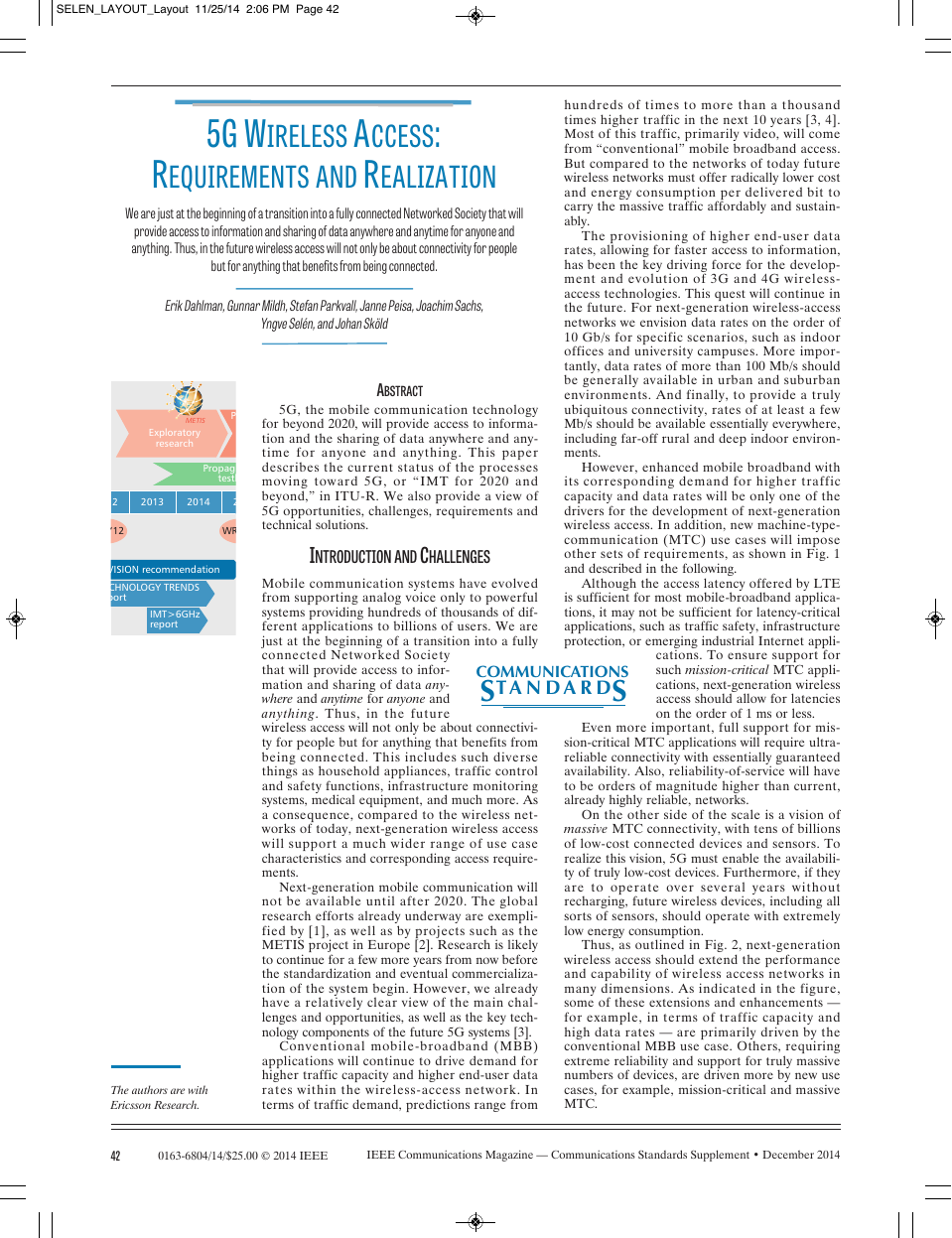

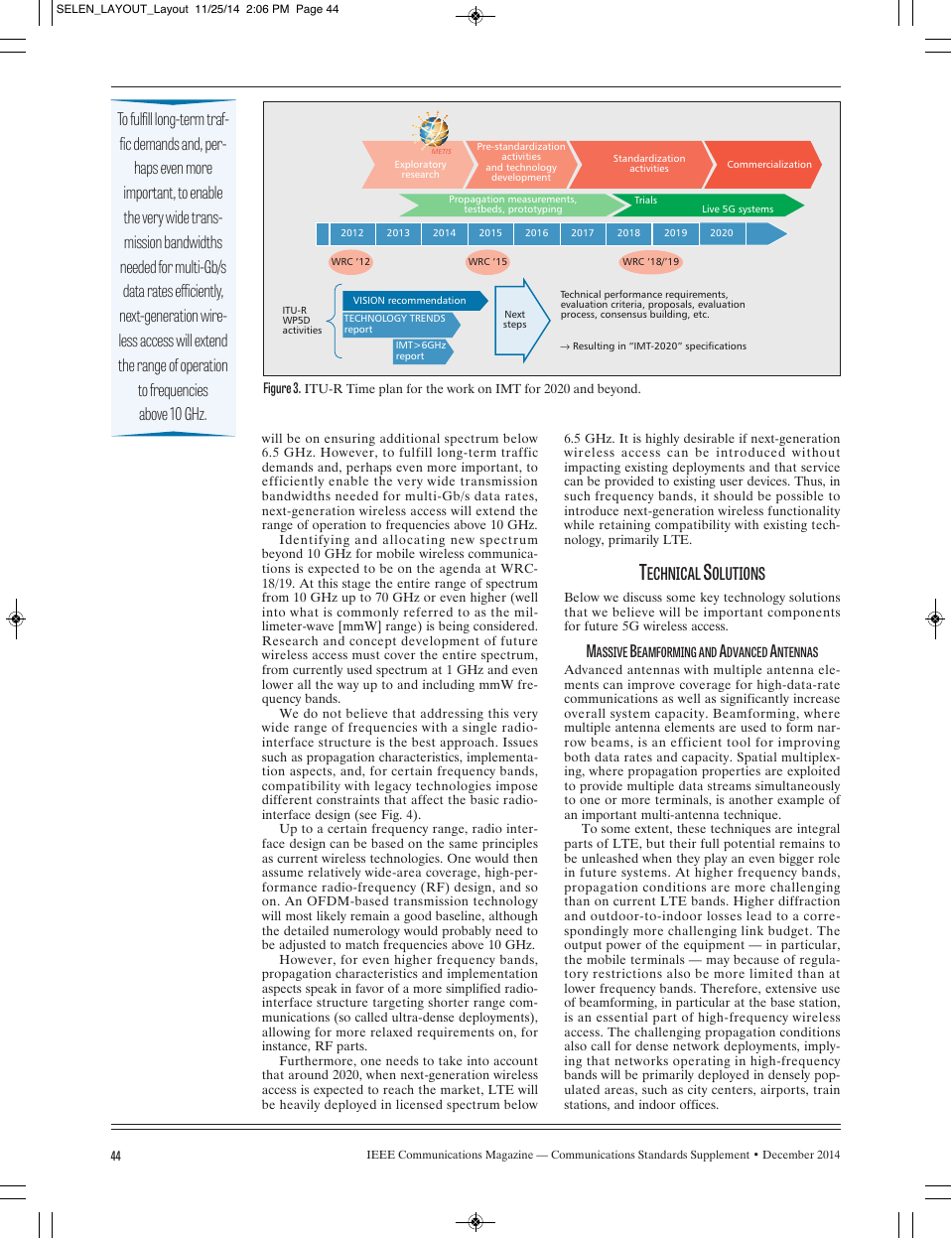
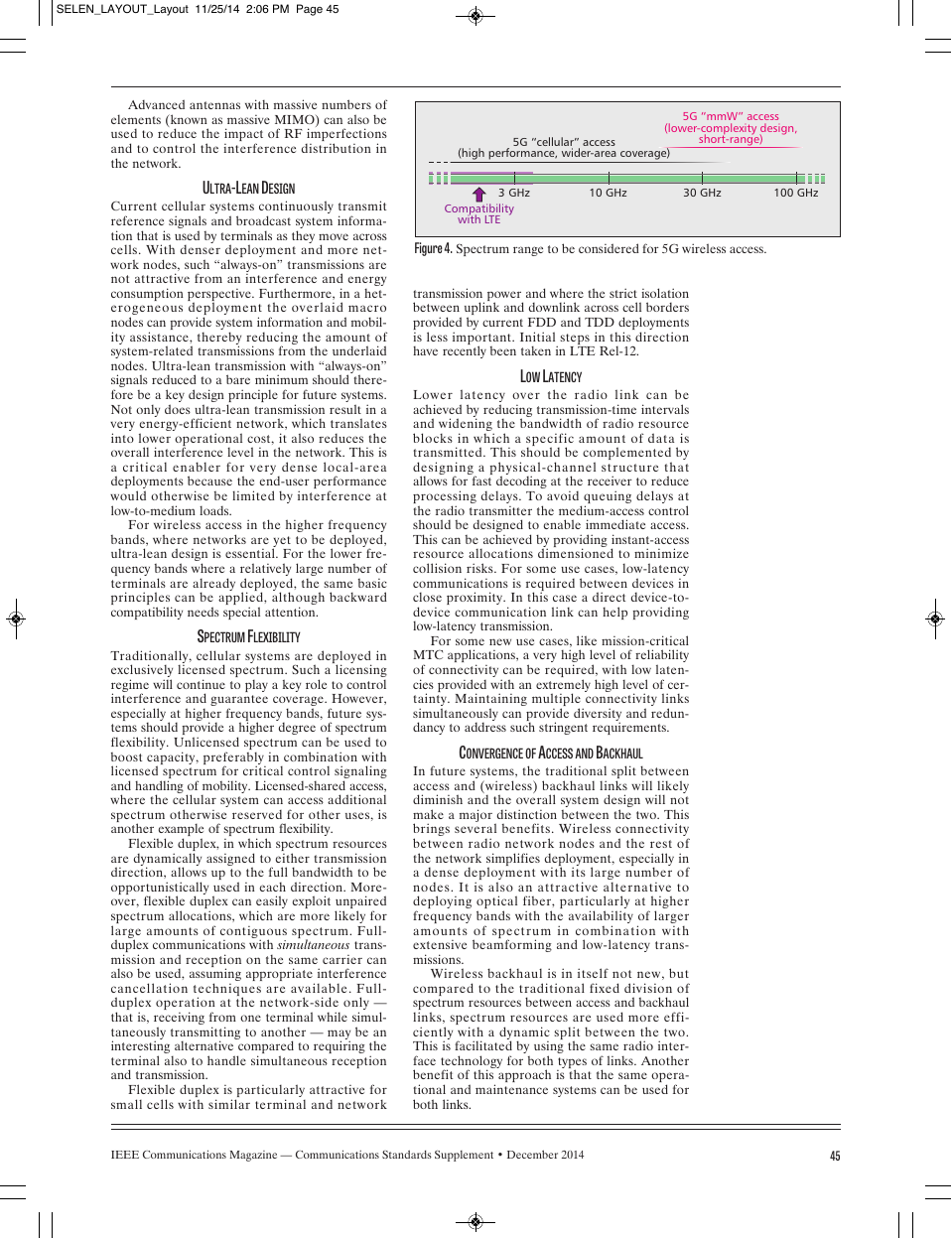
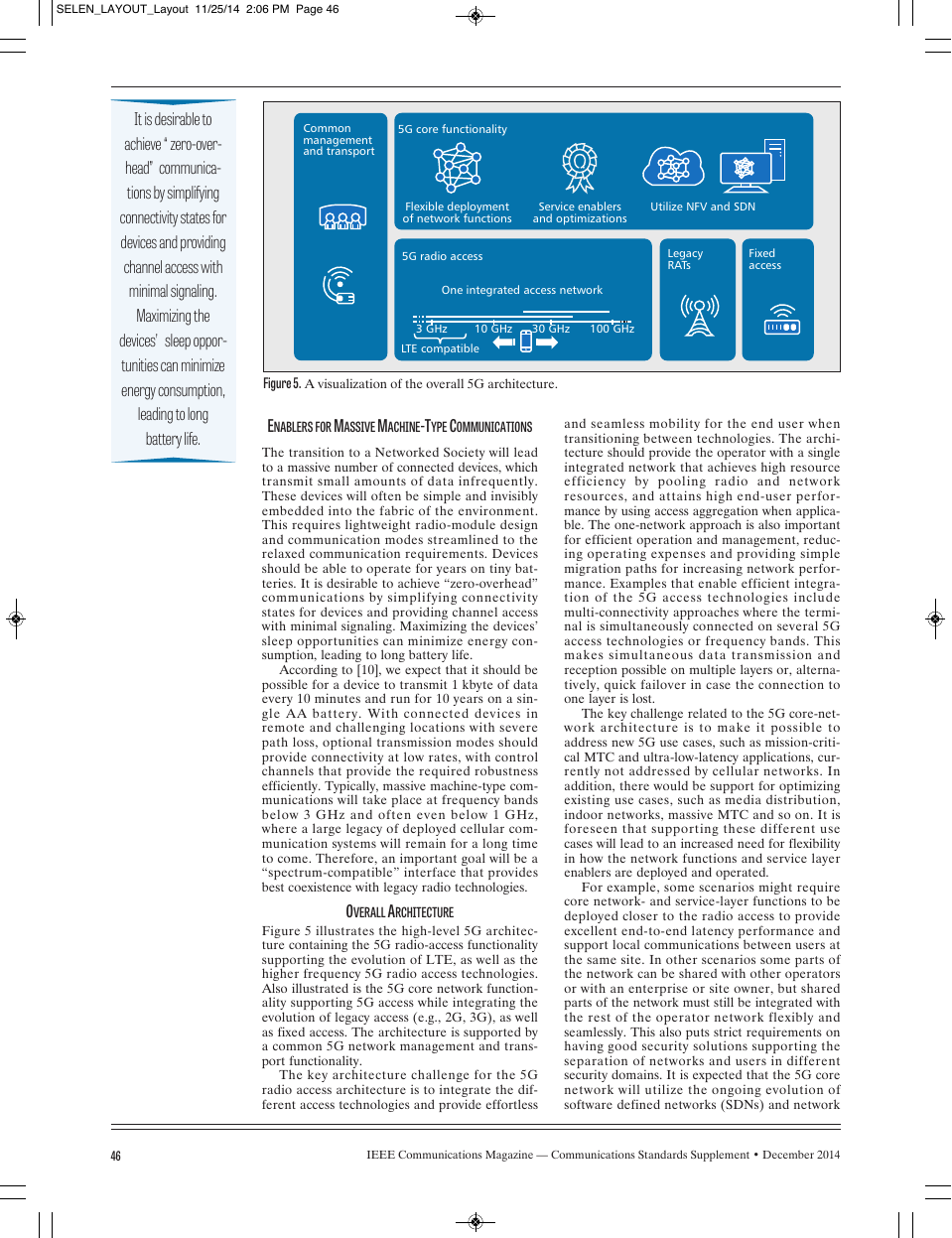
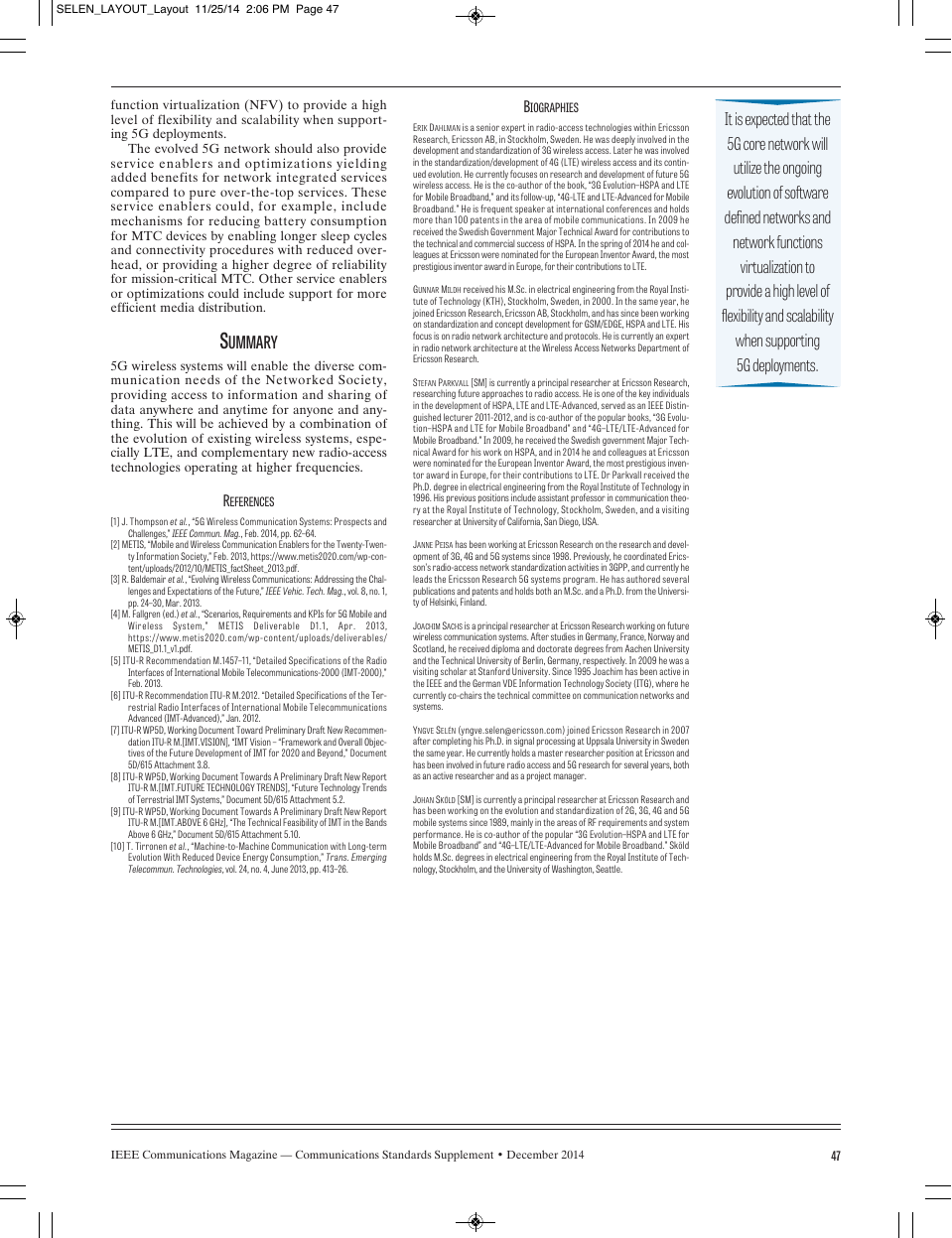






 2023年江西萍乡中考道德与法治真题及答案.doc
2023年江西萍乡中考道德与法治真题及答案.doc 2012年重庆南川中考生物真题及答案.doc
2012年重庆南川中考生物真题及答案.doc 2013年江西师范大学地理学综合及文艺理论基础考研真题.doc
2013年江西师范大学地理学综合及文艺理论基础考研真题.doc 2020年四川甘孜小升初语文真题及答案I卷.doc
2020年四川甘孜小升初语文真题及答案I卷.doc 2020年注册岩土工程师专业基础考试真题及答案.doc
2020年注册岩土工程师专业基础考试真题及答案.doc 2023-2024学年福建省厦门市九年级上学期数学月考试题及答案.doc
2023-2024学年福建省厦门市九年级上学期数学月考试题及答案.doc 2021-2022学年辽宁省沈阳市大东区九年级上学期语文期末试题及答案.doc
2021-2022学年辽宁省沈阳市大东区九年级上学期语文期末试题及答案.doc 2022-2023学年北京东城区初三第一学期物理期末试卷及答案.doc
2022-2023学年北京东城区初三第一学期物理期末试卷及答案.doc 2018上半年江西教师资格初中地理学科知识与教学能力真题及答案.doc
2018上半年江西教师资格初中地理学科知识与教学能力真题及答案.doc 2012年河北国家公务员申论考试真题及答案-省级.doc
2012年河北国家公务员申论考试真题及答案-省级.doc 2020-2021学年江苏省扬州市江都区邵樊片九年级上学期数学第一次质量检测试题及答案.doc
2020-2021学年江苏省扬州市江都区邵樊片九年级上学期数学第一次质量检测试题及答案.doc 2022下半年黑龙江教师资格证中学综合素质真题及答案.doc
2022下半年黑龙江教师资格证中学综合素质真题及答案.doc